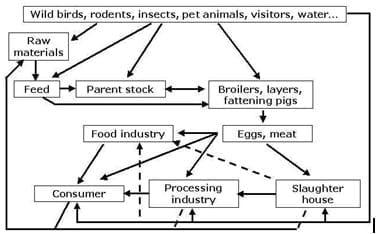Salmonella control
Salmonella control in the food chain (Part III)


Dear Dr. Hettiarachchi,
only the undissociated form of organic acids are able to pass through the cell membrane of gram-negative bacteria. Thus only the structure HCOOH (for formic acid) is able to pass the membrane and not H+ and COO- (the dissociated form). Since diformates are double salts of organic acids (a diformate molecule combines formic acid and formate) it is possible for the molecule (the formic acid part) to have the direct anti-bacterial effect. This also holds true for other acids, provided the fact that they arrive in the intestine, where the bacteria proliferate. And as stated before, diformate have been found to reach the intestine in animals with 85% of its ingredient still active, thus much higher than pure organic acids may reach.
Dear Dr. Hettiarachchi,
you mentioned a number of limitations organic acids or organic acid blends may have. True, buffer capacity has to be kept in mind - most buffering effect comes from minerals as well as from the protein content; hence diets with a high mineral loas and/or protein content should receive higher dosages of acidifier in order to maintain a low pH in the sotmach/proventriculus. Another limitiation of organic acids is that they are readiuly available to the metabolism of the bird and only limited amounts will reach the intestine (duodenum(jejunum...) where pathogenic bacteria may proliferate. Here, the effect of organic acids cannot be the reduction of the surrounding pH per se, but rather the direct anti-microbial effect of the undissociated part of the acid (which is able to enter through the membrane of gram-negative bacteria - this causes an energy expenditure of the bacteria which will lead utlimately to bacteria cell death). Diformates have shown to be active in the intestine of animals - up to 85% of the product have still been found here, whereas pure, volatile acids may reach only in single digit percent levels the same place in the GI-tract of birds.
Dear Mr. Emmanuel,
yes - organic acid salt - like potassium diformate; and you mentioned an available tradename - Aquaform, can also be used to enhance performance and digestibility in catfish. As of now there are trials available for the Asian catfish - Pangasius. Since the digestive system of the "catfish range" is rather similar you can expect a beneficial impact of potassium diformate in clarias as well.
Dear Dr. Anant,
due to a different mode of action (the undissociated form of the organic acid is able to enter the gram-negative bacteria cell and causes loss of energy...which will weaken/kill the bacteria) resistance of bacteria against organic acids has not been described/published. The case of using low levels of acidifier is often reported in Asia. I guess in this forum the MIC - minimal inhibitory concentration - has been discussed already. There are simple rules when an acidifier can work - among them is the dosage: if you are going to kill bacteria you have to supply acids in a dosage which is at least as high as the MIC-level. Different acids have different MIC-levels. Formic acid is among the strongest, and you need at least 1.5 kg/t of formic acid to successfully counteract for instance Salmonella. But please mind! These data are from labs under controlled conditions and the pure acid is used! Therefore under the wide variety of conditions in a commercial farm with several verctors from where Salmonella could "attack" plus products on the market which contain between 20-100% acids you can guess that an effective dosage will be considerably higher than the aforementioned level. My suggestion - check your product for the amount of active ingredients and test your biosecurity/management for possible "entrance points"...



.jpg&w=3840&q=75)











.jpg&w=3840&q=75)